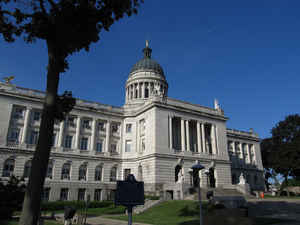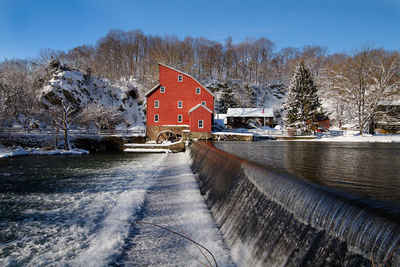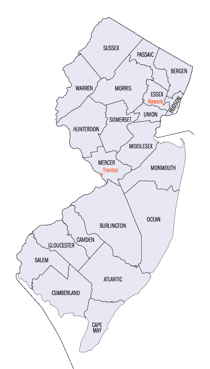New Jersey Counties
New Jersey has twenty-one counties. New Jersey's first counties were created as administrative districts within each province, with East Jersey split in 1675 into Bergen, Essex, Middlesex and Monmouth counties, while West Jersey's initial counties of Burlington and Salem date to 1681. The most recent county created in New Jersey was Union County, created in 1857.Bergen County, New Jersey
Bergen County Education, Geography, and History
Bergen County is the most populous county in the state of New Jersey. As of 2014, Bergen County's Census-estimated population was
933,572. Bergen is believed to be named for either Bergen-op-Zoom, the Netherlands or Bergen, Norway.
Located in the northeastern corner of New Jersey and its Gateway Region, Bergen County is part of the New York City Metropolitan Area and
is situated directly across the George Washington Bridge from Manhattan.
Etymology - Origin of Bergen County Name
The origin of the name of Bergen County is a matter of debate. It is believed that the county is named for one of the earliest settlements, Bergen, in modern-day Hudson County. However, the origin of the township's name is debated. Several sources attribute the name to Bergen, Norway, while others attribute it to Bergen op Zoom in the Netherlands. Still others attribute it to the Dutch word meaning "hill" or "place of safety". Some sources say that the name is derived from one of the earliest settlers of New Amsterdam (now New York City), Hans Hansen Bergen, a native of Norway, who arrived in New Netherland in 1633
Demographics:
County QuickFacts: CensusBureau Quick Facts
Bergen County History
Bergen was one of the four original counties in New Jersey. Its early borders reached into what are now Passaic and
Hudson counties. Bergen County today is a 239-square-mile parcel of land in the northeast corner of the state, with a
population of over 900,000 people.
Although Bergen was designated a "judicial district"in 1675, it was not until 1683 that the Provincial Assembly passed
an act creating the counties of Bergen, Essex, Middlesex and Monmouth.
In 1710, Hackensack was designated as the county seat. The oldest records of the Bergen County Board of Freeholders and
Justices are dated May 19, 1715. At that meeting, it was decided to build a combined courthouse and jail which was
erected on Hackensack's historic Green in 1716.
Bergen County observed the 300th anniversary of its founding on March 7, 1983. In 1985, the voters approved a
governmental change which had been recommended by the Bergen County Charter Study Commission, elected a year earlier to
assess the freeholder form of government.
In November 1986, Bergen's form of government changed. Instead of nine freeholders, voters chose a County Executive and
seven freeholders.
Geography: Land and Water
As reported by the Census Bureau, the county had a total area of 246.671 square miles (638.87 km2), of which 233.009 square
miles (603.49 km2) (94.5%) was land and 13.662 square miles (35.38 km2) (5.5%) was water.
Bergen County's highest elevation is Bald Mountain near the New York state line in Mahwah, at 1,164 feet (355 m) above sea level. The
county's lowest point is sea level, along the Hudson River, which in this region is a tidal estuary.
The sharp cliffs of the New Jersey Palisades lift much of the eastern boundary of the county up from the Hudson River. The relief becomes
less pronounced across the middle section of the county, much of it being located in the Hackensack River valley or the Pascack Valley. In
the northwestern portion of the county, Bergen County becomes hilly again and shares the Ramapo Mountains with Rockland County, New York.
The damming of the Hackensack River and a tributary, the Pascack Brook, produced three reservoirs in the county, Woodcliff Lake Reservoir
(which impounds one billion gallons of water), Lake Tappan (3.5 billion gallons), and Oradell Reservoir, which allows United Water to
provide drinking water to 750,000 residents of northern New Jersey, mostly in Bergen and Hudson counties. The Hackensack River drains the
eastern portion of the county through the New Jersey Meadowlands, a wetlands area in the southern portion of the county. The central
portion is drained by the Saddle River and the western portion is drained by the Ramapo River. Both of these are tributaries of the
Passaic River, which forms a section of the southwestern border of the county.
Neighboring Counties
Bordering counties are as follows:
- Rockland County, New York to the north
- Manhattan and the Bronx in New York City
- Westchester County, New York, across the Hudson River to the east; and within New Jersey, by Hudson County
- Essex County to the south
- Passaic County to the west.
Education
Bergen County is home to several colleges and universities:
- Bergen Community College - Paramus, with other centers in Hackensack and Lyndhurst
- Fairleigh Dickinson University - Teaneck and Hackensack
- Felician College - Lodi and Rutherford
- Ramapo College - Mahwah
- Saint Peter's University - Englewood Cliffs
Bergen has some 45 public high schools and at least 23 private high schools.







